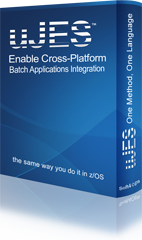 uJES: Linking applications, servers, services, databases & legacy systems.
uJES: Linking applications, servers, services, databases & legacy systems.
Why choose uJES? uJES provides many cost effective features to control Java platforms:
- One language, One Methodology to synchronize all events
- One set of commands to control all your servers
- One common learning curve to understand all the platforms processes
- One staff profile is sufficient to control all servers
- One Universal Agent for Cross-platform event communication, monitoring and synchronization
- One identical Catalog and File management system on each server
- One common and secure working methodology
- The possibility to complement or optionally replace your current batch scheduling agents for TWS, CA7, Control-M, Zeke and others
uJES: Open & Portable Architecture
- uJES works with UNIX, Linux, Mac OS , Windows and any server supporting Java SE 1.6
- Consolidate server and z/OS mainframe events using the uJES z/OS Bridge
- Consolidate various servers events using the uJES Universal Bridge
- Remote control operations using the uJES iPad Console
- Works "Stand Alone" or connected with IBM z/OS mainframes
- Ujes optional Extensions: CUPS Printer Support, Java Security Extension, Unix Services Integration,Mailbox Reader and Printer
uJES brings z/OS File and command facilities to Java platforms.
- Readers, Initiators and Printers;
- Centralized Control of Jobs and Outputs;
- JES like Job Management using Job Class and Job Priority;
- JES Data Sets for In Stream data (Sysins) and System Outputs (Sysouts);
- z/OS like Consoles and Console Management;
- z/OS Catalogs and Data Sets;
- z/OS JCL Interpretation and z/OS Utility emulation;
- z/OS Partitioned Data Sets and Generation Data Group;
- z/OS Input Data Set Concatenation;
- Data Set Allocation and Release according to Disposition;
- Independent batch job and event scheduling software agent;
- RACF like Security to control Program Execution and Data Set Access.

